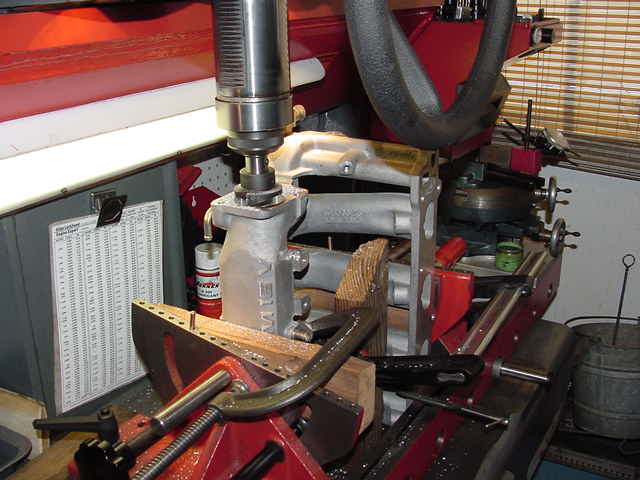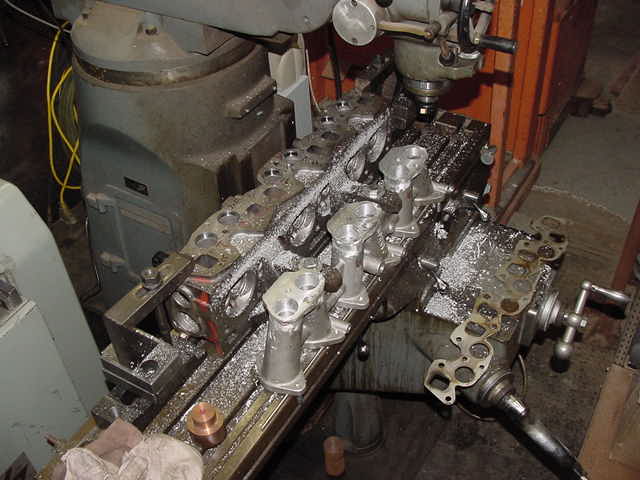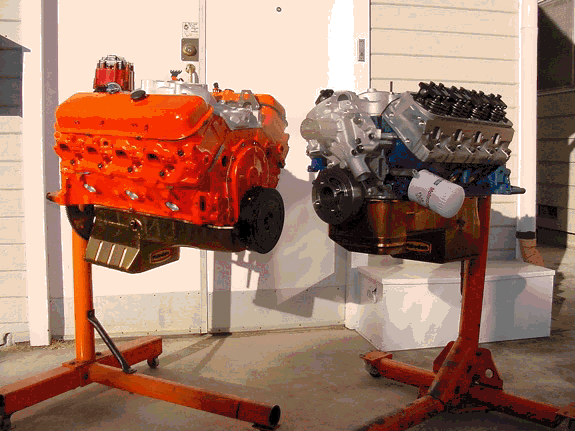
| Saturn Twin Cam Flow Test and Manifold Boring | TVR / TR-6 Engine | Jeep Engine Block Machining |
| A Chevrolet 454 and Ford 347 Stroker |

Saturn Twin Cam Flow test and manifold boring. This Bay Area customer wanted as much power as possible for a street racer project in 2003. His plans were for a turbo / nitrous injected setup. He wanted me to find

This looks like a very powerful head design. A solid tappet conversion was worked out that removed 28 gms of reciprocating weight and a new valve spring designed that should let the engine go to 10,000 RPM. The head, manifold, new parts, throttle body and project notes were sold to Brian in Florida for his street racer project in 2008. I hope he finishs it and has some fun.
TVR 2500 / TR-6 Engine
 I
then ported the head and removed nearly all of the
exhaust guide hump and guide extension. The intake side was
also ported in a maximum way while paying close attention
to minimum material removal and creating
equal runner
volumes. Final flow testing was done with a
finished manifold, dummy air box, and Webber
carburetors in place. Intake flow is 125 cfm @ .530 lift @ 25". Intake
runner volume is about 211cc's up from 196cc's when stock (valve to
carb
inlet face). Exhaust flow is 102 cfm @ .545 lift @
25"(with
a short head test pipe). Thermal barrier coated headers were prepared
for the TVR chassis identical to TR-6 factory racing designs.
I
then ported the head and removed nearly all of the
exhaust guide hump and guide extension. The intake side was
also ported in a maximum way while paying close attention
to minimum material removal and creating
equal runner
volumes. Final flow testing was done with a
finished manifold, dummy air box, and Webber
carburetors in place. Intake flow is 125 cfm @ .530 lift @ 25". Intake
runner volume is about 211cc's up from 196cc's when stock (valve to
carb
inlet face). Exhaust flow is 102 cfm @ .545 lift @
25"(with
a short head test pipe). Thermal barrier coated headers were prepared
for the TVR chassis identical to TR-6 factory racing designs.
Jeep Engine Block Machining. This flathead GPW Ford block was sleeved, bored, and had the guides replaced before being ready for conversion to hardened seats and getting a valve job. I had to consider it just a "large" cylinder head and strapped it to the table of my Serdi machine. It just fit and turned out well. Then the crankcase was crack repaired and cleaned for assembly in 2005.

These are two engine projects done in 2001 for different customers with two different goals.
The orange Chevrolet 454 is going to be installed in a 1968 El Camino. Pat bought his El Camino new but did not have resources for the engine option he really wanted back then. Now it is a little easier for him so he is having a frame off restoration / modification process done to build a street cruiser for Hot August (and a few other) Nights. This 454 is mildly cammed and has modest compression increases. The valves are bigger and pocket ported. The valve train is modified for endurance. It has a modified oil pan and windage tray. There are many detail and blueprint improvements and some changes to lighten internal weight. His goal is smooth torque and quiet, easy running when coupled to a turbo 400 transmission.
The blue Ford 302 is for an older Bronco 4x4. Jon wanted about all the power he could get for off road trails and still pass California emission testing. This engine was stroked to 347 Cid and has light weight parts. It has been carefully clearanced and is fitted with trick flow heads and valve train parts. I designed a roller cam based off specific air flow and engine dimensions which Competition Cams ground. It has a modified oil system and sump in addition to a ported manifold. I modified the Bronco to accept coated headers and twin catalytic converters in a specifically designed exhaust system. I converted it to an electric fan with an over sized radiator and Jon lifted it 4 inches necessitating numerous small changes to linkages and general configuration. With an OEM Autolite 2 BBL carburetor and a full ERG, AIR, EVAP emission system calibration it produces amazing torque, about 300 ft lb. @1000 RPM which is held to past 4000 RPM. This engine can be put into high gear at 25 mph and will quickly pull well past 110 mph without a stumble, or ping, or vibration. In 110 degree ambient air temperatures it still runs cool and strong @ 8.58 to one static compression ratio. These were challenging, fun, and expensive engines to build but should give Pat and Jon years of trouble free service.
